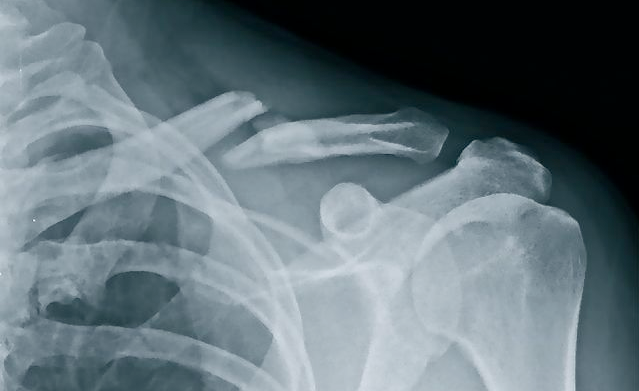
Clavicle fractures – also known as broken collarbones – are very familiar to cyclists, but the collarbone isn’t really in your neck. It’s one of two long, thin bones that connect the breastbone to your shoulder blades. The bones act as an attachment point of several muscles. Keeping them in one piece is sometimes difficult for cyclists.
The Common Crash
The bike crash is a perfect example of how and why cyclists break collarbones. There’s that natural tendency to break the fall from a crash by putting your arm out. The arm sends the force of the impact up your arm to the collarbone and snap. If you don’t put your arm out, and have your hands on the bars, your shoulder contacts the pavement hard, resulting in the same thing, a fractured clavicle.
How to Know
X-rays are the only sure way to discern if you’ve broken your collarbone, but there are other ways to figure it out for yourself. Right after a crash, if you notice that the weight of your arm is causing excruciating pain to your shoulder, and you immediately grasp your forearm in an attempt to relieve the weight of your arm because of pain — you might have broken your collarbone. Watch for it when other riders go down. If you see someone clutching their arm after a crash, it’s a symptom that their collarbone could be in trouble.
Keep Riding?
Some cyclists can still ride with a broken collarbone. Tyler Hamilton is a perfect example, he rode the 2003 Tour de France with a fractured collarbone, seemingly in denial of the pain. Thanks to adequate taping, and not to mention bravery, he stayed in the race. It’s not recommended to keep riding with a broken collarbone.
Signs of a Mild Broken Collarbone
Look for a few indicators that are similar with most collarbone issues.
- Pain and swelling
- Trouble moving your arm
- Sagging shoulder
- Grinding sound when you move your arm
- Bulging around your shoulder
Signs of a Serious Break
- Tingling in your arms or shoulders, numbness
- Deformed or odd-looking shape
Collateral Damage
Surgery Option
Surgery Risks
Take it Personal
To Feel Better
Ice Schedule
Apply the ice for about 20 minutes each hour while awake. After the first day, ice the area every 3 or 4 hours for 20 minutes at a time for at least 2 days or longer. Over the counter pain relievers can be used, but only under the care of your personal physician. If you have high blood pressure, heart disease or stomach ulcers for example, they can cause problems such as bleeding, bleeding can also occur if you take medications within 24 hours of your injury. It’s not advisable to take anything within 24 hours unless directed to do so by a health care professional. After that, if you need a stronger medication to relieve pain, consult with your personal doctor.
The Sling
You will need to wear a sling or wrap while your collarbone is healing to keep your collarbone in the right position. The sling also prevents you from moving your arm, which you will already know by now, is painful. Once you can move your arm without excessive pain, you can start easy exercises to increase the strength and movement in your arm. When you get to this point, you will be able to wear your sling less.
Activity and Recovery
Build your strength back slowly after you restart any activity. If your collarbone begins to hurt, stop and rest. It’s advisable to avoid placing stress on your arm, and avoid contact sports for a month after collarbones have healed.
When to Call the Dr.
Call your doctor if you have concerns about how your collarbone is healing. Certain symptoms should result in an immediate call:
- Your arm becomes numb, or has pins and needles feeling.
- The pain isn’t diminished with pain medicine
- Fingers turn blue, black, white or pale
- Trouble moving fingers
- Bone is coming out of the skin…duh
Collarbone Break Healing Time
Recovery is dependent on the injury and the medical support. Most cyclists report that they were able to resume riding on an indoor trainer one week after surgery, and outdoor cycling after four weeks.
Generally speaking bones heal within 6 weeks of breaking and collarbones are no different. You will be back to 90% at 6 weeks and it will take another month or so until you are full confident again. If you have any pain after 6 weeks, you need to get get checked again.
Do not try and do too much too soon, especially in the first few days of healing as the bone is setting. What are a few days or weeks in a lifetime?
In the meantime ride safe and have fun. Try not to break your collarbone cycling.